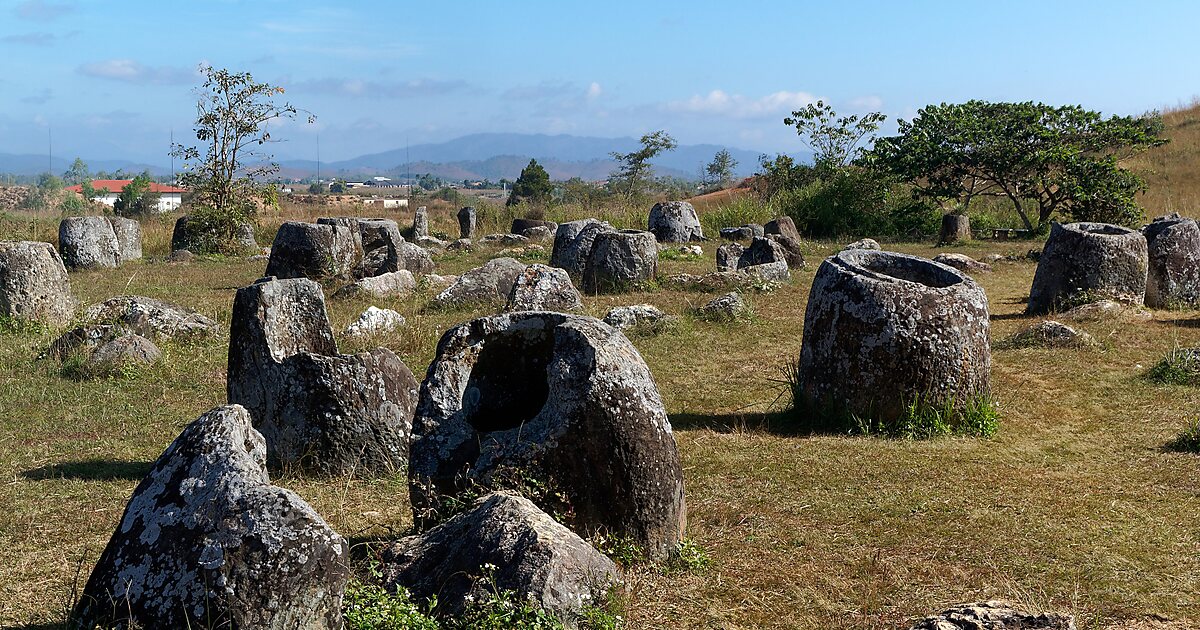The Historical Significance Of The Plain Of Jars In Xiangkhoang
Share
The Plain of Jars, located in the Xiangkhoang Province of Laos, is one of the most enigmatic archaeological sites in Southeast Asia. Known for its massive stone jars scattered across the landscape, this site has intrigued historians, archaeologists, and travelers alike. The jars, which vary in size and shape, are believed to date back to the Iron Age, around 500 BC to 500 AD. Their purpose, however, remains a mystery, leading to various theories and speculations about the ancient cultures that once inhabited this region.
The Enigmatic Jars: What Are They?
The Plain of Jars features thousands of stone jars, some weighing several tons, spread across more than 60 sites in the Xiangkhoang Plateau. The largest jars can reach up to three meters in height. While the exact origin and purpose of these jars are still debated, many researchers believe they were used for funerary practices, possibly to hold the remains of the deceased.
Theories Surrounding the Jars
-
Funerary Practices: One of the most widely accepted theories is that the jars were used in ancient burial rituals. Archaeological evidence suggests that the jars may have contained human remains or other burial goods, indicating a complex belief system surrounding death and the afterlife.
-
Storage Containers: Another theory posits that the jars were used as storage containers for food or water. This idea is supported by the jars' large size, which could accommodate significant quantities of goods.
-
Cultural Significance: Some researchers suggest that the jars may have had a more symbolic role, representing the social status of the individuals buried nearby or serving as markers for sacred sites.
Archaeological Discoveries
Archaeological excavations in the Plain of Jars have uncovered various artifacts, including pottery, tools, and remnants of ancient settlements. These findings provide insight into the lives of the people who inhabited the region and their cultural practices.
The Role of the Plain of Jars in Ancient Societies
The Plain of Jars is not just a collection of stone structures; it represents a significant aspect of the cultural and historical landscape of Laos. The site reflects the social, political, and spiritual dynamics of the communities that once thrived in this area.
-
Trade and Interaction: The location of the Plain of Jars suggests it may have been a hub for trade and interaction among different tribes and cultures. The presence of various artifacts indicates that the people of this region were engaged in trade with neighboring areas.
-
Cultural Exchange: The jars may also symbolize the cultural exchanges that occurred between different ethnic groups in the region. The diversity of artifacts found at the site points to a rich tapestry of interactions among ancient societies.
The Impact of War on the Plain of Jars
The historical significance of the Plain of Jars is further complicated by the impact of war. During the Vietnam War, the region was heavily bombed, leading to significant destruction and loss of life. The remnants of this conflict can still be seen today, as unexploded ordnance (UXO) poses a danger to visitors and locals alike.
Preservation Efforts
In recent years, efforts have been made to preserve the Plain of Jars and promote its significance as a UNESCO World Heritage Site. These initiatives aim to protect the jars from further damage and to raise awareness about the cultural heritage of Laos.
Visiting the Plain of Jars
If you're planning a visit to the Plain of Jars, there are several key points to consider:
Best Time to Visit
The best time to visit the Plain of Jars is during the dry season, which runs from November to April. During this period, the weather is more pleasant, with less rain and cooler temperatures, making it ideal for exploring the site.
How to Get There
The Plain of Jars is accessible from the town of Phonsavan, which serves as the main base for visitors. You can reach Phonsavan by bus or private vehicle from Vientiane or Luang Prabang. Once in Phonsavan, local tours are available to take you to the various jar sites.
What to Expect
Visitors to the Plain of Jars can expect a unique experience, with opportunities to learn about the history and significance of the jars. Guided tours often include visits to multiple sites, providing a comprehensive overview of the archaeological findings.
Conclusion: A Journey Through Time
The Plain of Jars in Xiangkhoang is more than just an archaeological site; it is a testament to the rich history and cultural heritage of Laos. As you walk among the ancient jars, you can't help but feel a connection to the past and the people who once inhabited this land. The mysteries surrounding the jars continue to captivate the imagination, inviting travelers to ponder the stories they hold.
Whether you're a history enthusiast, an adventure seeker, or simply curious about the world, the Plain of Jars offers a unique glimpse into the ancient civilizations that shaped the region. Don't miss the chance to explore this remarkable site and uncover its secrets for yourself.
For those planning a visit, consider booking your accommodations and flights through the following links to ensure a smooth and enjoyable trip:
With its rich history and stunning landscapes, the Plain of Jars is a destination that promises to leave a lasting impression.





